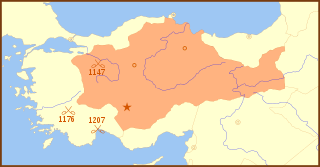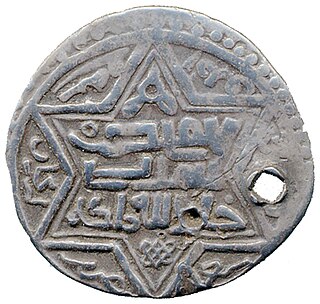
Kilij Arslan II or ʿIzz ad-Dīn Kilij Arslān ibn Masʿūd was a Seljuk Sultan of Rûm from 1156 until his death in 1192.

The Karamanids, also known as the Emirate of Karaman and Beylik of Karaman, was one of the Anatolian beyliks, centered in South-Central Anatolia around the present-day Karaman Province. From the mid 14th century until its fall in 1487, the Karamanid dynasty was one of the most powerful beyliks in Anatolia.

The Sultanate of Rûm was a culturally Turco-Persian Sunni Muslim state, established over conquered Byzantine territories and peoples (Rûm) of Anatolia by the Seljuk Turks following their entry into Anatolia after the Battle of Manzikert (1071). The name Rûm was a synonym for the medieval Eastern Roman Empire and its peoples, as it remains in modern Turkish. The name is derived from the Aramaic (rhπmÈ) and Parthian (frwm) names for ancient Rome, itself ultimately a loan from Greek Ῥωμαῖοι (Romaioi).

The Danishmendids or Danishmends was a Turkoman beylik that ruled in north-central and eastern Anatolia from 1071/1075 to 1178. The dynasty centered originally around Sivas, Tokat, and Niksar in central-northeastern Anatolia, they extended as far west as Ankara and Kastamonu for a time, and as far south as Malatya, which they captured in 1103. In early 12th century, Danishmends were rivals of the Seljuk Sultanate of Rum, which controlled much of the territory surrounding the Danishmend lands, and they fought extensively against the Crusaders.

Haji Bektash Veli was an Islamic scholar, mystic, saint, sayyid, and philosopher from Khorasan who lived and taught in Anatolia. His original name was Sayyid Muhammad ibn Sayyid Ibrāhim Ātā. He is also referred to as the "Sultan of Hearts" and the "Dervish of the Dervishes".
Ala ud-Din Timurtash was a member of the Chupanid family who dominated politics in the final years of the Ilkhanate.

Alā ad-Dīn Kayqubād ibn Kaykhusraw, also known as Kayqubad I, was the Seljuq Sultan of Rûm who reigned from 1220 to 1237. He expanded the borders of the sultanate at the expense of his neighbors, particularly the Mengujek Beylik and the Ayyubids, and established a Seljuq presence on the Mediterranean with his acquisition of the port of Kalon Oros, later renamed Ala'iyya in his honor. The sultan, sometimes styled Kayqubad the Great, is remembered today for his rich architectural legacy and the brilliant court culture that flourished under his reign.

Mu'in al-Din Suleiman Parwana, better known as Parwana was a Persian statesman, who was for a time a key player in Anatolian politics involving the Seljuk Sultanate of Rûm, the Mongol Ilkhanate and the Mamluks under Baybars.

Ghiyath al-Din Kaykhusrawibn Kayqubād or Kaykhusraw II was the sultan of the Seljuqs of Rûm from 1237 until his death in 1246. He ruled at the time of the Babai uprising and the Mongol invasion of Anatolia. He led the Seljuq army with its Christian allies at the Battle of Köse Dağ in 1243. He was the last of the Seljuq sultans to wield any significant power and died as a vassal of the Mongols.
Kayqubad II was the Seljuk Sultan of Rûm from 1249-1257. He was the only son of the Seljuq Sultan of Rûm Kaykhusraw II and the Georgian princess Gurju Khatun. Kaykhusraw's elder sons, by different mothers, were Kaykaus II and Kilij Arslan IV, and also served as sultan after their father's death, often simultaneously. As son of the sultan’s favorite wife, he was designated heir. He had a weak constitution and was likely seven years old at the time of his father’s death in 1246.
Baba Ishak, also spelled Baba Ishāq, Babaî, or Bābā’ī, a 13th-century preacher, led an uprising of the Turkoman of Anatolia against the Seljuq Sultanate of Rûm well known as Babai Revolt c. 1239 until he was hanged in 1241.
Jimri was a pretender to the Sultanate of Rum, promoted by the Turkmen in the chaos after Baibars’ invasion of Mongol-dominated Anatolia in 1277. He was executed the following year. The pretender’s formal name, ‘Ala al-Din Siyavush, appears on his few coins, but the sources almost invariably refer to him by the derogatory nickname Jimri, or “the Miser”.
On April 15, 1277, the Mamluk Sultan Baybars marched from Syria into the Mongol-dominated Seljuk Sultanate of Rûm and attacked the Mongol occupation force in the Battle of Elbistan (Abulustayn). Upon reaching Elbistan with at least 10,000 horseman, Baibars made ready for battle with the Mongols, expecting them to be around 30,000. The Mongol forces were smaller but they were supported by Armenians, Georgians and Rum Seljuks that bolstered their numbers. The Mamluk army was led by Baybars and his Bedouin Arab general Isa ibn Muhanna.

Qāżi Aḥmad Burhan al-Din was vizier to the Eretnid rulers of Anatolia. In 1381, he took over Eretnid lands and claimed the title of sultan for himself. He is most often referred to by the title Qadi, a name for Islamic judges, which was his first occupation.
The Battle of Yassıçemen was a battle fought in Anatolia, in what is now Erzincan Province, Turkey in 1230.

ʿAlāʾ al-Dīn Eretna was the first Sultan of the Eretnids, reigning between 1343–1352 in central and eastern Anatolia. Initially an officer in the service of Chupan and his son Tīmūrtāsh, he migrated to Anatolia following the latter's appointment as the Ilkhanid governor of the region. He took part in his master Tīmūrtāsh's campaigns to subdue the Turkoman chiefs of the western periphery of the peninsula. This was cut short by Tīmūrtāsh's downfall, after which Eretna went into hiding. Upon the dissolution of the Ilkhanate, he aligned himself with the Jalayirid leader Hasan Buzurg, who eventually left Anatolia for Eretna to govern when he returned east to clash with the rival Chobanids and other Mongol lords. Eretna later sought recognition from the Mamluk Egypt to consolidate his power, although he played a delicate game of alternating his allegiance between the Mamluks and the Mongols. In 1343, he declared independence as the sultan of his domains. His reign was largely described to be prosperous with his efforts to maintain order in his realm such that he was known as Köse Peyghamber.
Nûre Sûfi Bey was the founder of Karamanid dynasty, a Turkic dynasty which ruled part of Anatolia in the 14th and 15th centuries as a rival of the Ottoman Empire. He was the son of Hodja Sad al-Din who had come from Arran, staying for some years near Sivas.
Husam al-Din Choban was a commander and bey in the Sultanate of Rum in the early 13th century.
Selçukname is an informal term used for any of a number of medieval chronicles about Seljuk history written by different authors, mostly in Persian. It is also used for the 15th century Ottoman chronicle Tevârih-i Âl-i Selçuk. The Ottoman chronicle, written by Yazıcıoğlu Ali in Ottoman Turkish, is the only official history of the Imperial Court from Murad II's reign and serves to establish a narrative of the Ottoman dynasty's claim of descent through the Seljuks.
The Mongol invasion of Byzantine Thrace took place in the winter of AD 1263/1264. The Seljuk Sultan of Rûm Kayqubad II appealed to Berke, khan of the Golden Horde, to attack the Byzantine Empire in order to free his brother Kaykaus II.









